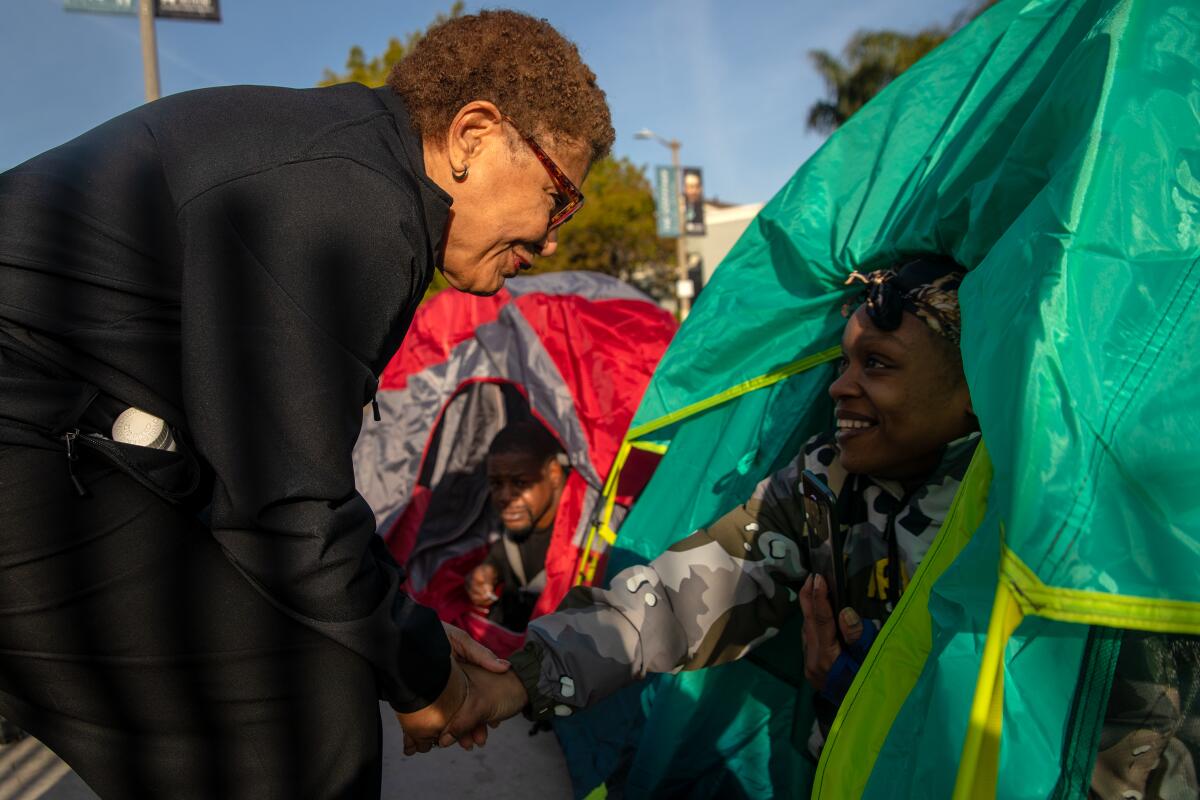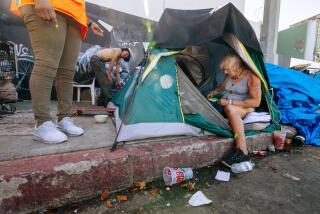Mayor Karen Bass says the city will house 4,000 homeless people during her first 100 days

- Share via
Los Angeles Mayor Karen Bass said Wednesday that she expects the city will have housed more than 4,000 homeless Angelenos by the time she reaches her 100th day in office.
Bass, appearing with her team at a City Hall discussion on homelessness, said she expects about 1,000 of those people will come from her Inside Safe program, which has been taking unhoused people off the streets and checking them into city-leased hotels and motels. Of the remaining 3,000, the vast majority are benefiting from housing programs put into motion before Bass took office, her team said.
The mayor reaches her 100th day on Tuesday.
Inside Safe has gone to 13 locations so far, heading most recently into Echo Park and skid row. Those operations have brought more than 500 people indoors so far, including 62 who have entered permanent housing with supportive services, the mayor’s team said.
Between now and next week, Bass intends to get to 1,000 in part by carrying out more encampment operations. In addition, unhoused people are being moved out of winter weather homeless shelters and into temporary housing, including the L.A. Grand Hotel, which has been serving as a city homeless facility since the outbreak of COVID-19. The mayor struck a deal several weeks ago to keep the hotel open past its scheduled Jan. 31 closure date.
Bass said the Inside Safe initiative has refuted the idea that unhoused people “do not want to leave the streets.”
Mayor Karen Bass’ Inside Safe initiative targeted an encampment that served as home to an estimated 98 people. By Monday, 82 had moved indoors.
“We have encountered people who said they don’t want to go,” she said. “But on move-out day — or move-in day — when the bus comes, even the people that said they’re not going, when they see other people going, they jump on the bus.”
Homelessness has been the top issue for Bass since she took office in mid-December. She has declared a citywide emergency over homelessness, ordered up reports on city property that can used for new housing and worked to strengthen ties with her counterparts in the county, state and federal government.
During last year’s mayoral campaign, Bass said she would move 17,000 homeless people indoors in her first year, relying on strategies that were projected to cost $292 million.
Sitting alongside homelessness czar Mercedes Marquez, Bass said her team has also encountered a number of problems over the last three months. In Westlake, her office had to move a group of unhoused residents out of a motel after learning that it had a serious roach problem. On the Westside, her team found that motel rates were frequently too expensive — and had to send encampment residents to motels in other neighborhoods.
City leaders are still developing a strategy for moving homeless people out of the hundreds of RVs that line city streets. One issue, the mayor said, is that many homeless people are renting those RVs from private owners. “We haven’t cracked that nut, but we are working on it,” the mayor said.
Speaking to reporters, the mayor’s team said more than 2,700 of the 4,000 homeless people being housed have been helped as a result of decisions made before Bass took office. For example, she said, the city has completed 614 units of permanent supportive housing, relying on funds from Proposition HHH, the $1.2-billion bond measure passed by voters in 2016 — well before Bass arrived at City Hall.
The mayor said that 1,336 homeless people have moved into interim housing, such as “tiny home” villages. Of that total, her team is taking credit for 36. An additional 775 people were helped by emergency housing vouchers. Bass said her team is taking responsibility for 143.
Council President Paul Krekorian praised Bass for making homelessness such a priority. “The efforts we are making are not the end, they are a beginning,” he said. “And I look forward to further progress in the year ahead.”
Earlier this year, Krekorian and his colleagues freed up $50 million for Bass’ homelessness initiatives. Of that total, more than $4 million has been spent and an additional $27 million has been allocated, much of it for motels, Bass said.
Some who work closely with homeless Angelenos voiced reservations about the mayor’s work. Peggy Lee Kennedy, who volunteers with the Venice Justice Committee, said she is troubled to see some unhoused people being moved far out of the neighborhoods where they had been living.
Get the lowdown on L.A. politics
Sign up for our L.A. City Hall newsletter to get weekly insights, scoops and analysis.
You may occasionally receive promotional content from the Los Angeles Times.
In January, an early Inside Safe operation in Venice sent dozens of people to a motel near Hawthorne.
That motel is “not even in the city of L.A. That’s unincorporated L.A. County,” Kennedy said. For those with medical appointments on the Westside, “that’s like an hour and 40 minutes on the bus or something.”
Bitta Sharma, an organizer with the grassroots outreach group Mar Vista Voice, said she too has concerns. In Del Rey, she said, encampment residents wound up being moved from motel to motel, living in three locations over just six weeks, she said.
“It seemed from the get-go to be extremely disorganized,” Sharma said, “and traumatic for the people who were being transported to hotels.”
Marquez, the homelessness czar, said the mayor’s team is still learning as it creates a citywide strategy for interim housing, which is meant to serve as a bridge between encampments and permanent homes.
“Every day we get stronger, and we learn from whatever mistake or miscue or painful experience that happens,” she said.
More to Read
Sign up for Essential California
The most important California stories and recommendations in your inbox every morning.
You may occasionally receive promotional content from the Los Angeles Times.












